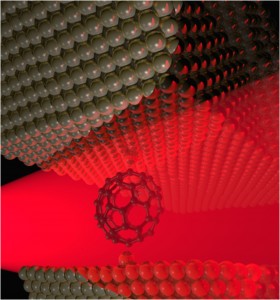A Jan. 16, 2014 Rice University news release landed in my mailbox this morning and revealed that researchers have ‘detuned’ or softened the atomic bonks in a molecule known as a buckminster fullenere (aka, buckyball),
Rice University scientists have found they can control the bonds between atoms in a molecule.
The molecule in question is carbon-60, also known as the buckminsterfullerene and the buckyball, discovered at Rice in 1985. The scientists led by Rice physicists Yajing Li and Douglas Natelson found that it’s possible to soften the bonds between atoms by applying a voltage and running an electric current through a single buckyball.
…
“This doesn’t mean we’re going to be able to arbitrarily dial around the strength of materials or anything like that,” Natelson said. “This is a very specific case, and even here it was something of a surprise to see this going on.
“But in general, if we can manipulate the charge distribution on molecules, we can affect their vibrations. We can start thinking, in the future, about controlling things in a better way.”
The effect appears when a buckyball attaches to a gold surface in the optical nano antenna used to measure the effects of an electric current on intermolecular bonds through a technique called Raman spectroscopy.
Natelson’s group built the nano antenna a few years ago to trap small numbers of molecules in a nanoscale gap between gold electrodes. Once the molecules are in place, the researchers can chill them, heat them, blast them with energy from a laser or electric current and measure the effect through spectroscopy, which gathers information from the frequencies of light emitted by the object of interest.
With continuing refinement, the researchers found they could analyze molecular vibrations and the bonds between the atoms in the molecule. That ability led to this experiment, Natelson said.
Natelson compared the characteristic vibrational frequencies exhibited by the bonds to the way a guitar string vibrates at a specific frequency based on how tightly it’s wound. Loosen the string and the vibration diminishes and the tone drops.
The nano antenna is able to detect the “tone” of detuned vibrations between atoms through surface-enhanced Raman spectroscopy (SERS), a technique that improves the readings from molecules when they’re attached to a metal surface. Isolating a buckyball in the gap between the gold electrodes lets the researchers track vibrations through the optical response seen via SERS.
When a buckyball attaches to a gold surface, its internal bonds undergo a subtle shift as electrons at the junction rearrange themselves to find their lowest energetic states. The Rice experiment found the vibrations in all the bonds dropped ever so slightly in frequency to compensate.
“Think of these molecules as balls and springs,” Natelson said. “The atoms are the balls and the bonds that hold them together are the springs. If I have a collection of balls and springs and I smack it, it would show certain vibrational modes.
“When we push current through the molecule, we see these vibrations turn on and start to shake,” Natelson said. “But we found, surprisingly, that the vibrations in buckyballs get softer, and by a significant amount. It’s as if the springs get floppier at high voltages in this particular system.” The effect is reversible; turn off the juice and the buckyball goes back to normal, he said.
The researchers used a combination of experimentation and sophisticated theoretical calculations to disprove an early suspicion that the well-known vibrational Stark effect was responsible for the shift. The Stark effect is seen when molecules’ spectral responses shift under the influence of an electric field. The Molecular Foundry, a Department of Energy User Facility at Lawrence Berkeley National Laboratory, collaborated on the calculations component.
Natelson’s group had spied similar effects on oligophenylene vinylene molecules used in previous experiments, also prompting the buckyball experiments. “A few years ago we saw hints of vibrational energies moving around, but nothing this clean or this systematic. It does seem like C-60 is kind of special in terms of where it sits energetically,” he said.
The discovery of buckyballs, which earned a Nobel Prize for two Rice professors, kick-started the nanotechnology revolution. “They’ve been studied very well and they’re very chemically stable,” Natelson said of the soccer-ball-shaped molecules. “We know how to put them on surfaces, what you can do to them and have them still be intact. This is all well understood.” He noted other researchers are looking at similar effects through the molecular manipulation of graphene, the single-atomic-layer form of carbon.
“I don’t want to make some grand claim that we’ve got a general method for tuning the molecular bonding in everything,” Natelson said. “But if you want chemistry to happen in one spot, maybe you want to make that bond really weak, or at least make it weaker than it was.
“There’s a long-sought goal by some in the chemistry community to gain precise control over where and when bonds break. They would like to specifically drive certain bonds, make sure certain bonds get excited, make sure certain ones break. We’re offering ways to think about doing that.”
Here’s a link to the abstract and a citation for the paper,
Voltage tuning of vibrational mode energies in single-molecule junctions by Yajing Li, Peter Doak, Leeor Kronik, Jeffrey B. Neatonc, and Douglas Natelsona. PNAS. doi: 10.1073/pnas.1320210111
This paper is behind a paywall so you need either a subscription to the journal or access to a research library with a subscription or, alternatively, there are two short-term rental options (which for reasons that escape me were difficult to access) here.
As business models go, I don’t believe that aspect of the PNAS model is going to prove successful. Why not make all the options available from the page containing the abstract as do other academic publishers?
Getting back to the buckyball, the researchers have provided an image to illustrate their work,
